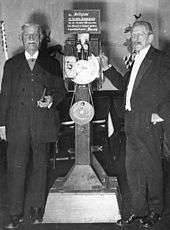Bioscop

The Bioscop was a movie projector developed in 1895 by the brothers Emil and Max Skladanowsky in Berlin-Pankow. The Bioscop used two loops of 54-mm films without a side perforation.

This caused poor control of the film-transport through the projector and might have contributed to the more successful development of the cinematograph by the French brothers Lumiere.
The first public performance of the movie scenes using the Bioscop was organized in the restaurant „Feldschlößchen“ in Berlin-Pankow, Berliner Straße 27. Three of the scenes became iconic for early cinematography, "The boxing Kangaroo", "The Wrestler" and "The Serpentine Dance". They were all shot earlier in the garden of the same restaurant. The ballroom of the "Felschlößchen" restaurant was later converted into the first permanent cinema in Germany and served the audience under the name "Tivoli" until it was closed in 1994 and demolished to make space for a discount supermarket. The Skladanovsky brothers later used the Bioscop to show movies to a larger audience in the Berlin Variete theater "Wintergarden". This can be considered the first movie program to a paid audience. In 1896, they traveled through the Netherlands and Skandinavia, presenting their invitation to the international audience. In Sweden the term Bio (short for Biograph) is still synonymous for "cinema".